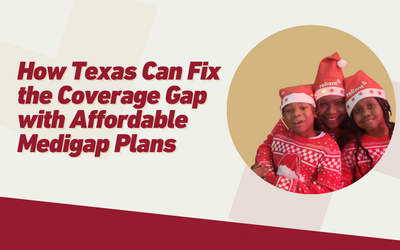
The Problem
Individuals under-age 65 with End Stage Renal Disease (ESRD) and Amyotrophic Lateral Sclerosis (ALS) are currently eligible for Medicare Part B coverage due to their qualified health conditions.
The problem is that while Texans under 65 have access to one Medigap plan, premiums are not affordable. Policies for people over 65 range from $102-$681 per month, while the same policies for enrollees under the age of 65 range from $332-$1731 per month (Medicare.gov).
A Patient Perspective
Lesley Perkins, a 62-year old, is exactly who Medigap plans are intended to help. She has spent the last several years on dialysis, works part-time and monitors her health carefully so she can be ready when a kidney becomes available for transplant.
“In 2021 I got very sick with double pneumonia,” Lesley shared. “From there, they diagnosed me with kidney disease. At first they thought I’d only need three months of dialysis, but I’ve been on dialysis ever since then. I go three days a week.”
A kidney transplant is the ideal treatment for end stage kidney disease. It frees people from the need to do dialysis, and can extend adult life expectancy by 8-12 years; a living donor can extend life even longer. Children who receive a transplant during their childhood can extend their life expectancy by thirty years.
Dialysis patients seeking a kidney transplant need supplemental insurance before they even go on a waitlist, because the post-transplant medical care costs are usually too much for individual families. Organs available for transplant are scarce, and recipients have an obligation to keep the transplanted organ as healthy as possible, for as long as possible.
It is hard to work, but Lesley is committed to her part-time job as a medical biller. ALS and ESRD patients often choose between paying medical bills, rent, food or other expenses.Some “spend down” assets to qualify for Medicaid so that the state pays for the 20% deductible and co-insurance, but that is a situation Lesley is trying to avoid.
“I can’t live on Medicaid,” she said. “To qualify for Medicaid I would have to stop working, I would have to get rid of my car so that I didn’t have any assets. But how would I get around? I would have to get my groceries delivered, I wouldn’t be able to go to church. I don’t want to live in a dangerous neighborhood, as a woman, and then have to take the bus everywhere.”
“I don’t want to take cruises and fancy vacations, I just want to live independently, somewhere safe and comfortable. I want to be able to pay my insurance premiums and my utilities, and those are expensive. So much of my income has to go to healthcare.”
It’s early in the calendar year, and patients like Lesley are paying the brunt of their deductibles and meeting their out-of-pocket requirements, but it’s a huge burden.
“When you have a chronic kidney disease, you have to have a high-protein diet, which means you’re buying more expensive food items. Meat is expensive. Eggs are expensive. So is water with supplements, the protein bars, protein powders. But you have to eat this way to control the disease exactly, and track things like calcium, potassium, vitamin D. They’re not going to give me a kidney if I’m not healthy enough.”
The Solution
Texas is considering bills to improve access to affordable Medigap plans (HB 2516 and SB 1945. Here are a few things to know about the bills, from the Texas Medigap Coalition.
- There is no impact to the state budget, as Medigap is private coverage.
- This proposed legislation could prevent cost-shifting to the state’s Medicaid program.
- It comes with very little, or no, cost to other insured people
If Texans had access to affordable Medigap, as many as 1 in 4 non-duals in Texas could annually avoid spending down their assets to enroll in Medicaid. - Almost 20 other states have worked to make their Medigap plans more affordable in order to help keep people off Medicaid.
If you want to help encourage your lawmaker to support the Medigap affordability bill, visit https://www.votervoice.net/CHRONICDISEASE/Campaigns/123665/Respond.